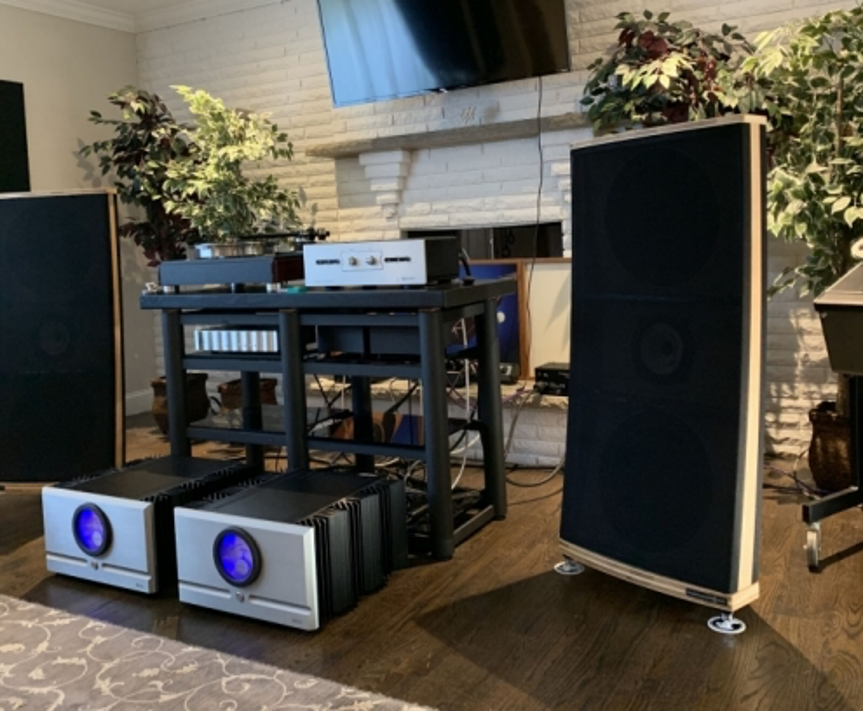
Note: This is Part 1 of a 2-part review. Don’t forget to take a look at Part 2 here to find out more about how the Trio Classics sound.
Walking the halls at the 2019 AXPONA show, the PureAudioProject sign grabbed my attention. I opened the door to the room, and a very inviting sound greeted me. Then my eyes cut to a beautifully sculpted set of speakers reminiscent of the larger Quad ESL 63s. This was my first look at the PureAudioProject Trio15 Classic speakers. Their style was not what I was used to seeing from this company.
PureAudioProject has been on my list of companies whose products I have wanted to review for quite some time. For many years, their sound has teased me at numerous audio shows. While the sound has been intriguing, the look was, shall we say, one that required a commitment to the product.
When a seat opened up, I sat down to listen. The sound from the Trio15 Classics yielded depth, tonal balance, and a relaxed yet detailed presentation of the music that I rarely hear in a show setting. I knew at that point that I was destined to audition/review these speakers.
Planning a Product Review
Since I already had several products in the pipeline to review, I waited until summer to contact Ze’ev Schlik, the owner of PureAudioProject, about reviewing the configuration that caught my attention at AXPONA.
I also contacted Tim Stinson at Luminous Audio Technology to see if I could get an Axiom II preamp on loan for the review. The system I heard at AXPONA used this passive preamp along with Pass Labs amplification. Tim sent me the Axiom II Walker Mod and some of his Luminous Audio Cables. I plan to review both of these sometime this Spring.
By the end of October, everything had arrived, and I was ready to start my listening. Before we get into those details, however, I should tell you a bit about PureAudioProject and what they offer.
The “Project” in PureAudioProject
By now, many of you may already be familiar with PureAudioProject. This company began in 2014 under the guidance of principal owner Ze’ev Schlik. Based in Israel, their business model is a truly global concept. They have fulfillment operations in the US and Germany, and they source parts for their products from around the world.
Immediately when you meet Ze’ev it’s apparent that what he is really selling is a love of MUSIC. The products he makes are merely different vehicles to get you there. Subsequent conversations with him only reinforced this initial impression. Our conversations centered more around connecting with the music and artist than they did about the technical details of the components. When technical talk came up, it was always with an eye on how the technology helps move you to connect with the music.
Some Assembly Required
Ze’ev described PureAudioProject’s initial offerings as “unique designs of modular and finished products that are shipped unassembled and are assembled by the customers.” That is correct. Until recently, most PureAudioProject speakers come with “some assembly required”. If you have ever put together a piece of flat-pack furniture, you can assemble your PureAudioProject speakers. The assembly instructions on the company’s website are excellent, and there are lots of glowing reviews on these speakers online.
The company’s goal with all of its speakers, configurations, and drivers is to move you closer to your musical nirvana, whatever it may be.
The Win-Win Birth of a Classic

As his company grew, Ze’ev began to sense the need for a preassembled “turn-key” product that could fit into a home environment without triggering an immediate call for family counseling.
Enter the Trio15 Classic, a home-friendly preassembled version of the company’s popular Trio15. A true win-win. The Trio15 Classic’s sculpted look with curved front and rear grilles offer a much higher spousal acceptance factor. However, it still maintains the option of trying different crossover components and configurations along with different drivers.
The Trio Classic Drivers
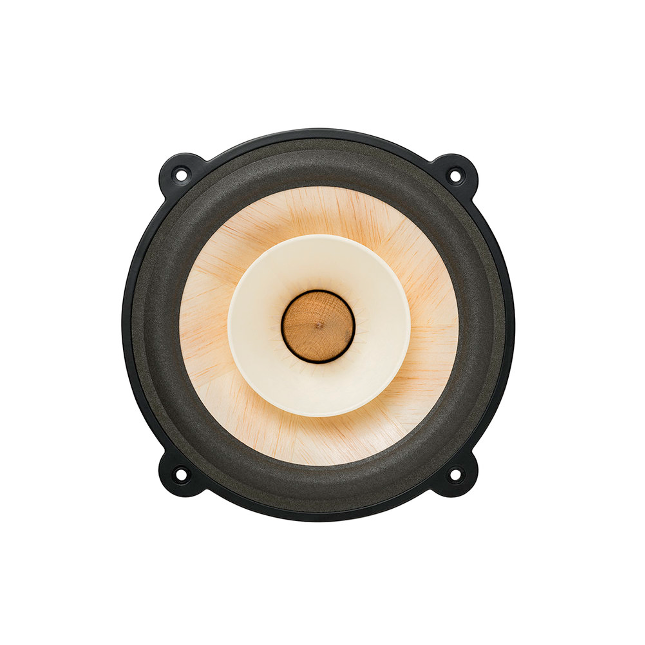
PureAudioProject offers the Trio15 Classic with your choice of either the Voxativ AC-1.6 driver or the wood-coned AC-PiFe driver shown here. Both are full-range drivers.
Voxativ is a newer German loudspeaker company. It’s out to compete with the likes of Lowther and Fostex, industry stalwarts in the production of full-range drivers.
Voxativ also makes their own loudspeakers, and their neutral and open midrange is quite intoxicating. However, the extension and detail on the top end surprise me. I must confess that my previous impression of full-range drivers was formed a few years ago. While they have a wonderful midrange, they lack the transparency I desire in the upper frequencies. They are also not dynamically expressive enough for my taste.
This is not so with the Voxativ driver. Apparently, I have been under a rock regarding this subject, and my old impressions needed updating. While they are not cheap by any measure, their build quality and sound are special. The AC-1.6 driver sells for $2,000/pair, and the AC-PiFe drivers that are used in the speakers I reviewed sell for $4,000/pair.
Even though the Voxativ drivers are classified as full-range components, the Trio15 Classic design rolls them off in the 200-300hz area where it hands the bass off to the four 15″ woofers.
Custom-designed Woofers
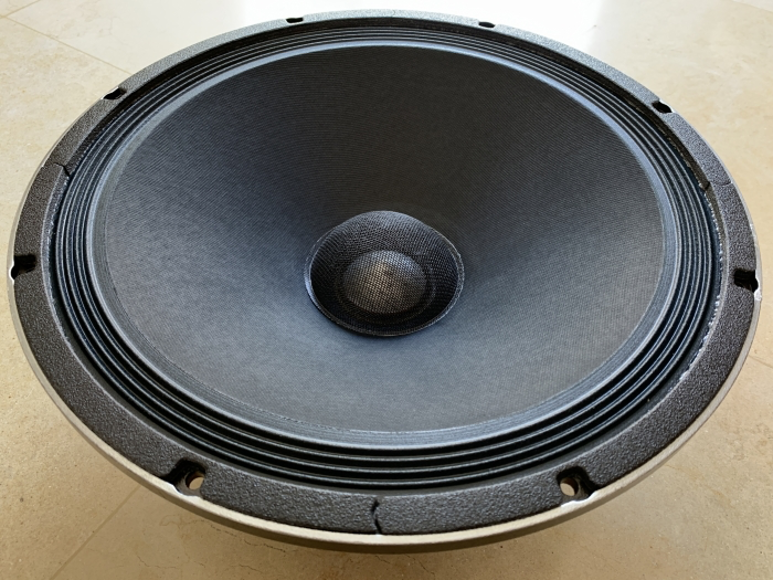
PureAudioProject designed the OB-A15Neo 15” woofers that are used in the Trio15 Classic speakers in cooperation with Eminence. They are designed for use specifically in open baffle speakers. These woofers have a very fast response that excels in a deep bass. They are also capable of operating up into the lower midrange. That ability lets them integrate smoothly with the other drivers PureAudioProject offers in their designs.
New Thrier Crossover
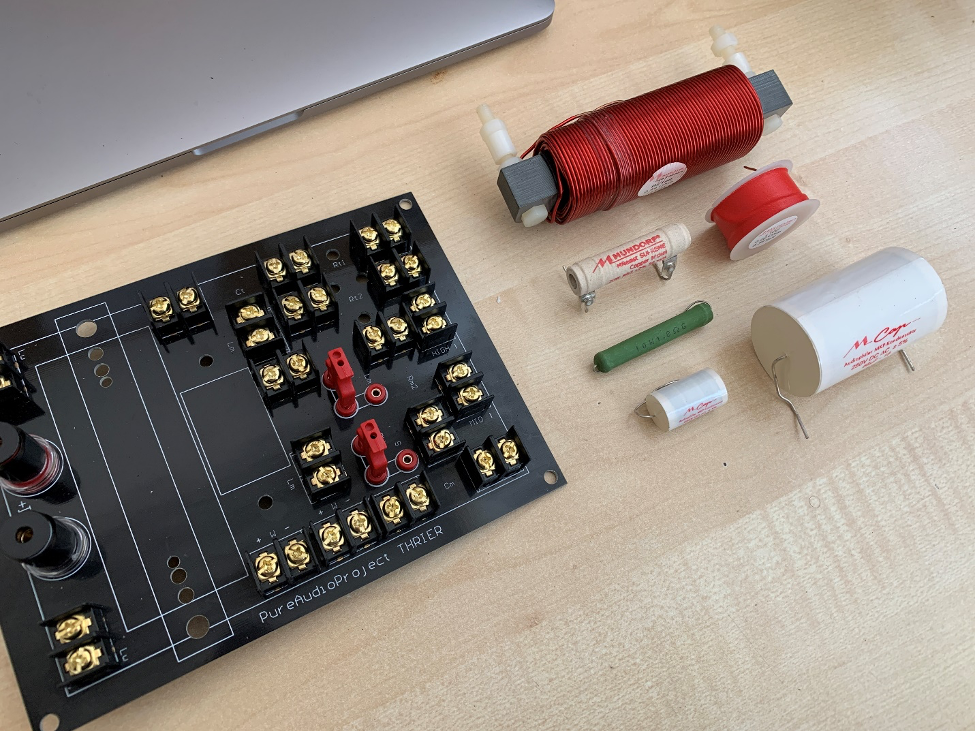
PureAudioProject is using their new Thrier crossover pictured here in the Trio15 Classic speakers. The company plans to use this crossover in almost all of its speakers going forward. The Thrier is a modular crossover that uses high-quality German Mundorf components throughout.
With the Thrier crossover, you can swap components with only a screwdriver. This lets you experiment with various brands and values of capacitors, resistors, and wiring. With this crossover, you do not need technical skills or to solder anything.
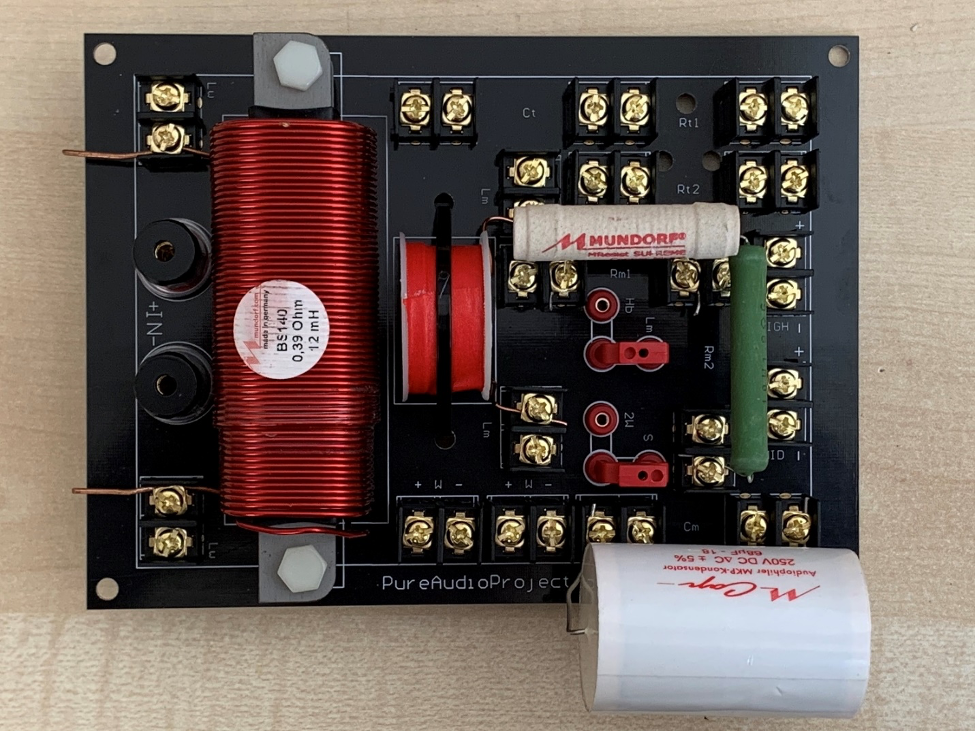
Why Move to a New Crossover?
I asked Ze’ev to describe the new Thrier and why the company made the move from their long-offered Leonidas crossover.
ZS: The vast majority of loudspeaker designers use 2nd order (-12db/oct) parallel crossover topology i.e. low, mid, and/or high channels are in parallel. Parallel topology and 2nd order is a relatively straightforward design that is supported by advanced software and simulation tools. Our Leonidas crossover was a two-way 1st order (-6db/oct) series topology filter (with drivers in series on the same audio path) All components were mounted to a PCB with screw terminals and not by soldering. This allowed customers to 1) swap the crossover components when trying different models 2) gently fine-tuning the crossover to the customer’s personal sonic preference, gear, and room conditions and, 3) experimenting with different capacitors, resistors, or coils, an extremely rewarding procedure!
Series topology can present an extremely organic sonic experience that is magical, however, this is highly dependent on drivers themselves and their sonic synergy when blending over a wide cross-section.
With time we have launched more driver options and three-way models like the Trio 15Coax 10”, and the Thrier crossover was launched to meet these upcoming requirements. It features the option to choose between series and parallel topologies, it has a third channel for three-way speakers or a super tweeter and is 100% backward compatible.
PureAudioProject Active Analog Crossover
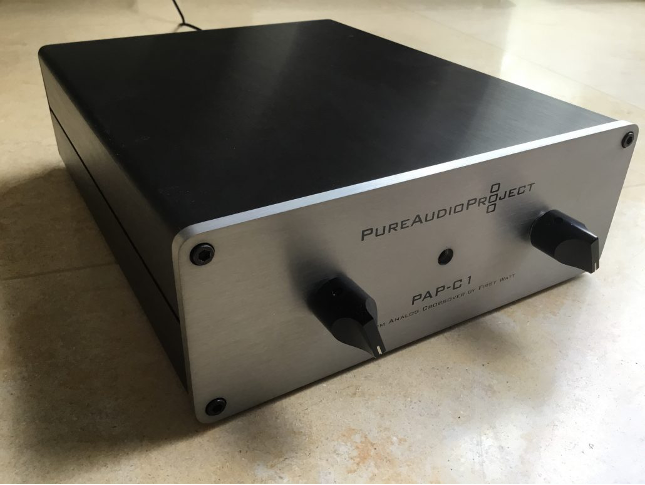
By the way, if bi-amping is your thing, PureAudioProject offers their PAP-C1. This Active Analog Crossover was designed by none other than Nelson Pass and First Watt in conjunction with PureAudioProject for use with two-way open baffle designs.
Open Baffle Sound
Frankly, for many years, I have been perplexed by the lack of coverage for open baffle speakers from the mainstream audio press. For so long, open baffle designs seemed to be banished to the DIY hobbyists and audio forums. Finally, in the last few years, the qualities of open baffle sound that attract me are deservedly getting more attention.
Back in the 1980s and 1990s, audio dealers sold a lot of Dahlquist, Acoustat, and Infinity speakers. To this day, I maintain a pair of each of these in my speaker collection. However, I wasn’t “locked-in” on open baffle until I stumbled into Seigfried Linkwitz’s room at an audio show four or five years ago and heard his LX 521s. That encounter, both with the speaker and with Seigfried’s kindness (may he rest in peace) made me refocus on open baffle design.
In my experience, open baffle design simply “frees up” the music. It sounds more like it is being played in the room rather than coming “from a box”. The lack of cabinet colorations will catch you off guard the first time you hear it. That along with its ease of placement in the room makes it a design whose popularity is on the rise.
Why Open Baffle Sound?
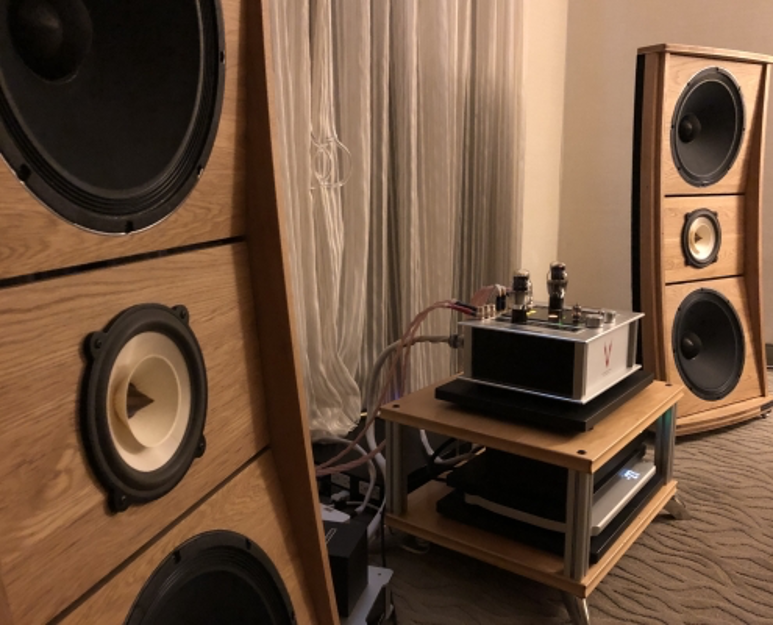
The picture above shows what’s behind the grills of the Trio15 Classic speakers. Here are some thoughts from Ze’ev about open baffle sound and why PureAudioProject uses this design in their speakers.
ZS: Our speakers are Open Baffle and dipole and their radiation pattern is not dominated by a box. Boxes recreate the feel of scale while small components are playing into a box. Open baffle speakers with large woofers simply move enough air without any need for additional energy transformation to make the music feel live! …Open baffle speakers, therefore, become part of the room and integrate with its acoustics rather than trying to impose its sonic signature on it. This is one of the reasons they sound so ‘natural’, no fatigue, and need for specific room treatment! Our ears are accustomed to our room’s ambiance and our speakers simply become a naturally integrated part of it…
My Listening Set Up
For this review, I used the Luminous Audio Axion II Walker Mod passive preamp with the PS Audio M1200 monoblocks and my Pass Labs SIT 3.
The sources most often used were my AMG Viella V12 Turbo turntable with the DS Audio Master One cartridge, my Studer A810 open reel with the King/Cello tape head preamp, and an Aurender streamer into a Denafrips Iris/Pontus combination.
One of the many attributes of open baffle design is how easily it integrates into your room. There is considerably less fuss to get the bass quality correct than with a box loudspeaker. The bass on an open baffle speaker seems to “play the room” whereas the bass in a box speaker many times seems to “fight the room.”
In my 20 x 24 x 15 room, I ended up with the speakers about 9 feet apart with my listening seat about 9 to 10 feet back. While they sounded best at 4 feet out from the front wall, I will note that they sounded very good at just 2 feet out. As always, some experimentation to find the best location for the speakers can be rewarding. However, it is easy to place open baffle speakers.
Final Thoughts on Setup
I also did notice that the Trio15 Classic is one of those speakers that sounds very good no matter where you are in your listening environment. The sound did not vary as much as I expected it to when I moved around my room. I attributed this to the polar response of the drivers and the open baffle design.
Finally, there are jumpers in the crossover that let you adjust two parameters.
- One adjustment is whether you have a coil in or out of the tweeter circuit. The coil is there to adjust the speaker to blend with your system and your listening preferences. PureAudioProject describes its effect as a “trimming” of the upper-frequency response. “It is important to note that there is no right or wrong setting …only the setting you prefer.” For my setup and during the review period I preferred the coil in the circuit.
- The other adjustment is the choice between series or parallel crossover topology. Again, there is no right or wrong. I would encourage you to try both settings. For this review, I used the Series topology.
I commend PureAudioProject for giving their customers the ability to make these adjustments. They enable you to optimize the speaker with your components and your room. Thank you!
I am fortunate enough to have a completely detached listening room, so once I got everything set up, I ran the speakers 24/7 for about 2 weeks. I used a combination of music and assorted break-in discs.
Stay tuned for my listening impressions in the upcoming Part 2.
Price US:
Trio15 Classic w/ Voxativ AC-1.6: $7,990
Trio15 Classic w/ Voxativ AC-PiFe: $9,990
Note: Prices are per pair and include shipping.

